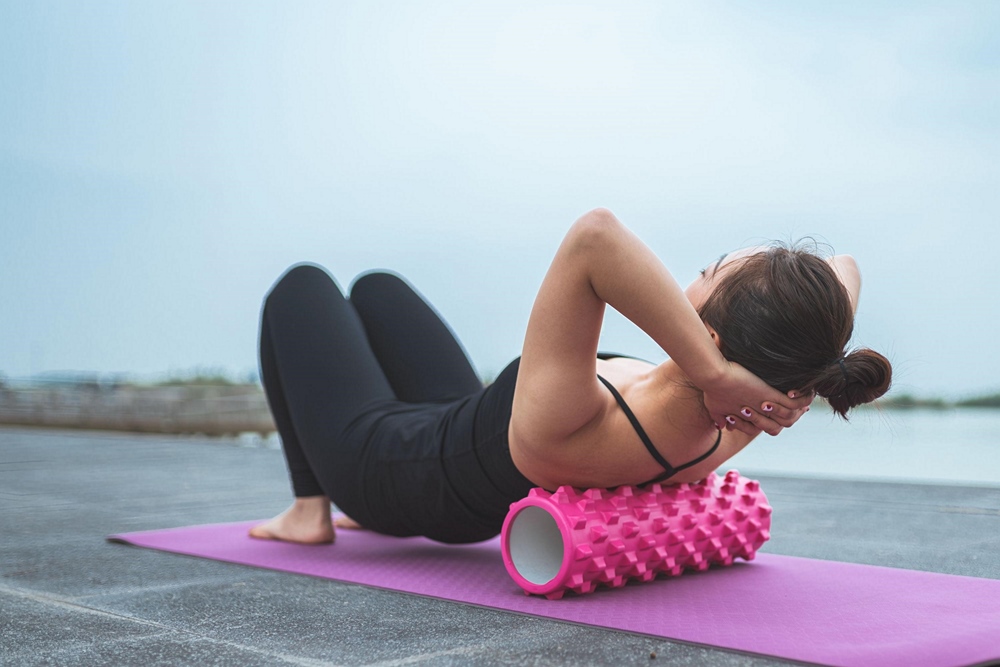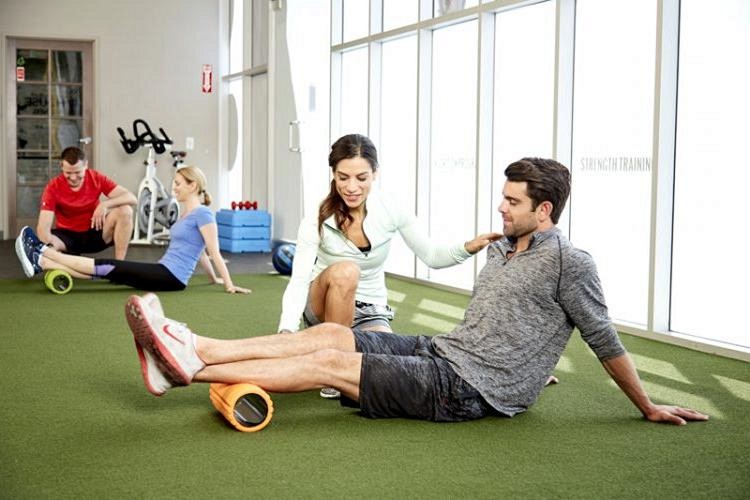Last Updated on: 18th December 2024, 12:35 pm
Foam rolling, a form of self-myofascial release, is akin to giving yourself a deep tissue massage. It involves using a cylindrical tube of compressed foam to roll over various parts of the body. This technique aids in breaking up adhesions and scar tissues, improving blood flow, and enhancing overall mobility. Stretching, on the other hand, is the deliberate lengthening of muscles to increase muscle flexibility and joint range of motion. Through gentle pulling of the muscles, stretching prepares the body for physical activity and reduces the risk of injuries.
- Flexibility and muscle health are crucial for injury prevention, faster recovery, and better performance.
- Incorporating foam rolling and stretching into your routine improves physical performance and well-being.
- These practices help prevent muscle stiffness and soreness, enhance posture, and reduce stress levels.
Understanding Foam Rolling

What is Foam Rolling and How Does It Work?
Foam rolling is a self-myofascial release technique that uses your body weight to apply pressure to muscle tissue. This process helps in smoothing out knots and tension points, promoting better blood circulation and flexibility.
Benefits of Foam Rolling
- Accelerates recovery by enhancing blood flow.
- Reduces the likelihood of muscle soreness.
- Increases flexibility and improves range of motion.
Types of Foam Rollers and How to Choose the Right One
From smooth to textured, and from soft to firm, foam rollers come in various shapes and densities. Selecting the right one depends on your personal preference and pain tolerance. Beginners might start with a softer, smooth roller, while seasoned users may opt for a firmer, textured roller for a deeper massage.
Common Foam Rolling Techniques and Best Practices
- Focus on muscle groups like the back, legs, and arms.
- Start with gentle pressure, gradually increasing as your muscles warm up.
- Spend extra time on tight spots but avoid rolling over joints and bones.
- Consistency is key; incorporating foam rolling into your daily routine yields the best results.
Delving into Stretching

Different Types of Stretching: Dynamic vs. Static
Stretching falls into two primary categories: dynamic and static. Dynamic stretching involves active movements where joints and muscles go through a full range of motion, preparing the body for physical activity. Static stretching entails holding a stretch in a comfortable position for a period of time, aimed at improving flexibility post-workout.
Benefits of Stretching for Flexibility and Injury Prevention
- Enhances flexibility and plays a crucial role in injury prevention.
- Increases blood flow to the muscles, reducing stiffness.
- Helps in maintaining proper posture and alignment during physical activities.
How to Stretch Properly: Techniques and Tips
- Begin with a warm-up to loosen the muscles.
- Aim for a gentle pull, not pain, and hold static stretches for about 30 seconds.
- Ensure smooth, controlled movements for dynamic stretches without bouncing.
- Integrate stretching into your daily routine for the best results.
The Role of Stretching in Warm-up and Cool-down Routines
Stretching is vital in both warm-up and cool-down routines. Dynamic stretches kickstart a warm-up, preparing the body for the workout ahead. Conversely, static stretching during cool-down helps to relax the muscles, restore them to their resting length, and reduce post-workout soreness. This balanced approach aids in recovery and ensures the body is well-prepared for future physical activities.
Foam Rolling vs. Stretching: Comparative Analysis


vs

Situations Where Foam Rolling is More Beneficial
- Ideal for athletes or individuals with muscle tightness and knots.
- Effective before a workout to increase blood flow and flexibility.
- Helps in recovery post-exercise by reducing muscle soreness.
Situations Where Stretching is More Advantageous
- Crucial for improving overall flexibility and range of motion.
- Static stretching is best performed after a workout to help muscles relax.
- Dynamic stretching is recommended before exercises to prevent muscle strains.
How Foam Rolling and Stretching Can Complement Each Other
Integrating both foam rolling and stretching into a fitness routine offers the best of both worlds. Foam rolling can precede stretching by loosening up the muscles, making them more receptive to the benefits of stretching. This combination enhances flexibility, reduces soreness, and improves overall performance.
Understanding the Limitations and Precautions of Each Method
- Foam rolling should be avoided on injured areas and not applied with too much pressure.
- Stretching requires attention to form and should never be painful. Overstretching can lead to muscle damage.
Practical Applications and Recommendations

Integrating Foam Rolling and Stretching for Athletes
Athletes can significantly benefit from incorporating foam rolling and stretching into their routines. Begin with foam rolling pre-workout to loosen tight muscles and enhance blood flow. This prepares the body for the demands of intense training. Post-exercise, engage in static stretching to aid muscle recovery and flexibility. This combination not only boosts performance but also minimizes the risk of injuries.
Daily Wellness Routine Incorporation
For those seeking to enhance their daily wellness routine, start or end your day with foam rolling to alleviate muscle tightness and promote relaxation. Follow this with a series of dynamic stretches in the morning to energize the body or static stretches in the evening to unwind and improve sleep quality. This practice supports not just physical health but also mental well-being.
Tailoring to Fitness Levels and Goals
Customizing foam rolling and stretching according to fitness levels and goals is key. Beginners should focus on gentle foam rolling and basic stretches, gradually increasing intensity as flexibility and tolerance improve. Advanced individuals can incorporate more targeted foam rolling and complex stretches to address specific needs and enhance performance. Listen to your body and adjust the intensity and duration to match your fitness journey.
Remember, consistency is crucial. Regularly integrating foam rolling and stretching into your routine maximizes benefits, leading to improved flexibility, reduced soreness, and enhanced overall performance. Whether you’re an athlete pushing limits or someone striving for a healthier lifestyle, these practices are invaluable tools in your fitness arsenal.
Conclusion: Making an Informed Choice

Throughout this exploration of foam rolling and stretching, key points have emerged to guide an informed choice in muscle maintenance:
- Foam Rolling: Excels in targeting deep tissue, enhancing circulation, and preparing muscles for exertion.
- Stretching: Paramount for improving flexibility and aiding in post-activity recovery.
Both practices, when applied correctly, serve as pillars for injury prevention and better athletic performance.
Attuning to the body’s signals is essential; discomfort should be a guide, not a deterrent. Professional guidance can optimize the benefits of foam rolling and stretching, tailoring them to individual needs and circumstances. It’s a journey of understanding the unique language of one’s own body.
Ultimately, the pursuit of flexibility and muscle health is a testament to the commitment to one’s overall health and fitness. Regularly engaging in these practices is not just about enhancing physical capabilities but also about nurturing a harmonious relationship with the body.
- Embrace the rhythm of foam rolling
- and the melody of stretching
to compose a symphony of well-being that resonates through every aspect of life.
Wrapping It Up
Foam rolling and stretching are key to optimal muscle health. Together, they forge a path to enhanced flexibility and injury prevention. By embracing both practices, individuals can navigate the delicate balance between pushing limits and nurturing recovery. This journey not only elevates physical performance but also deepens the connection with one’s body. Let’s commit to this dual approach, unlocking a symphony of well-being that supports our fitness aspirations and daily life.

